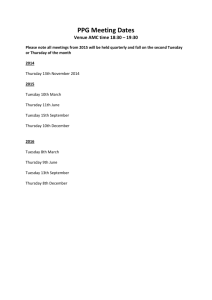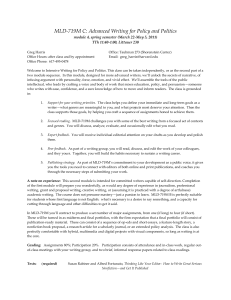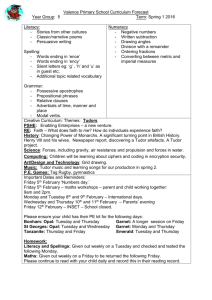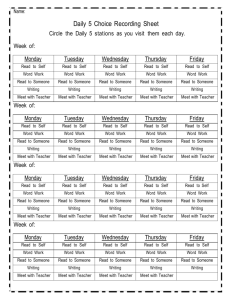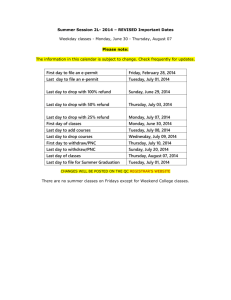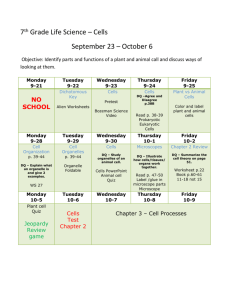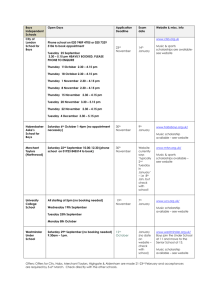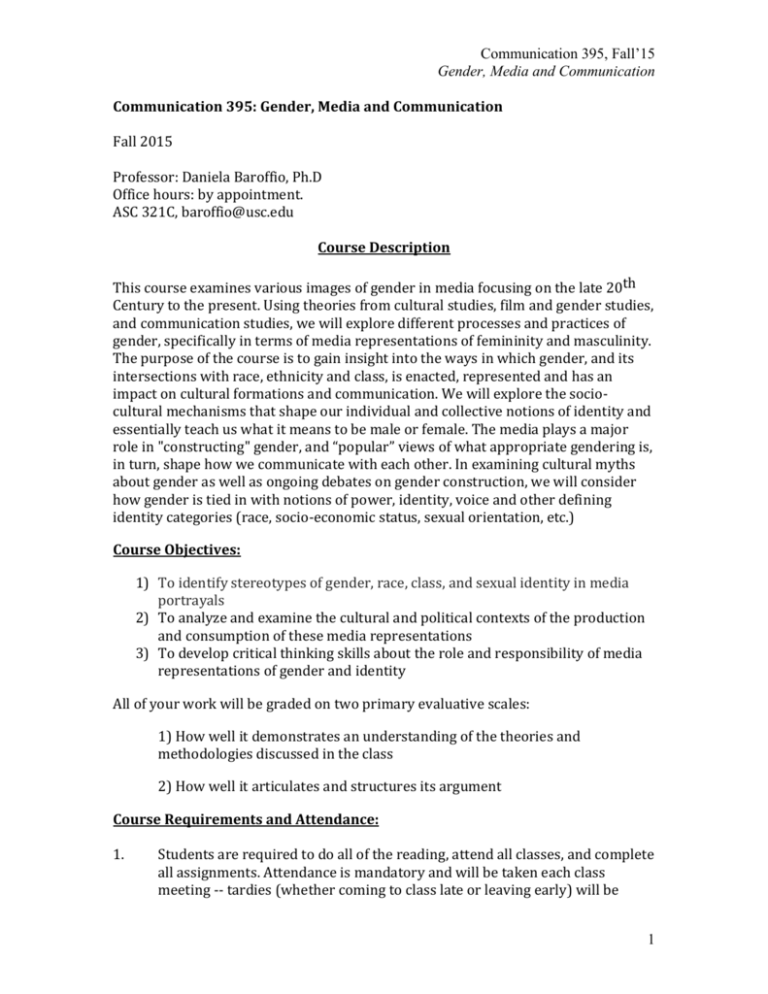
Communication 395, Fall’15
Gender, Media and Communication
Communication 395: Gender, Media and Communication
Fall 2015
Professor: Daniela Baroffio, Ph.D
Office hours: by appointment.
ASC 321C, baroffio@usc.edu
Course Description
This course examines various images of gender in media focusing on the late 20th
Century to the present. Using theories from cultural studies, film and gender studies,
and communication studies, we will explore different processes and practices of
gender, specifically in terms of media representations of femininity and masculinity.
The purpose of the course is to gain insight into the ways in which gender, and its
intersections with race, ethnicity and class, is enacted, represented and has an
impact on cultural formations and communication. We will explore the sociocultural mechanisms that shape our individual and collective notions of identity and
essentially teach us what it means to be male or female. The media plays a major
role in "constructing" gender, and “popular” views of what appropriate gendering is,
in turn, shape how we communicate with each other. In examining cultural myths
about gender as well as ongoing debates on gender construction, we will consider
how gender is tied in with notions of power, identity, voice and other defining
identity categories (race, socio-economic status, sexual orientation, etc.)
Course Objectives:
1) To identify stereotypes of gender, race, class, and sexual identity in media
portrayals
2) To analyze and examine the cultural and political contexts of the production
and consumption of these media representations
3) To develop critical thinking skills about the role and responsibility of media
representations of gender and identity
All of your work will be graded on two primary evaluative scales:
1) How well it demonstrates an understanding of the theories and
methodologies discussed in the class
2) How well it articulates and structures its argument
Course Requirements and Attendance:
1.
Students are required to do all of the reading, attend all classes, and complete
all assignments. Attendance is mandatory and will be taken each class
meeting -- tardies (whether coming to class late or leaving early) will be
1
Communication 395, Fall’15
Gender, Media and Communication
tracked along with absences. You are afforded TWO unexcused absences students who miss more than two lectures will have their grades reduced
and risk failing the course: there is a deduction of half a grade off the final
grade for each unexcused absence.
Note also that attendance grade may also be affected by your promptness
and level of attention during class lecture. Filling a seat does not constitute
participation. I understand that some students are more overtly involved
than others, however I expect all of you to find ways to contribute within the
classroom by being supportive listeners, thoughtful speakers, and respectful
peers.
2.
Competing Media: While in class, you are expected to be fully present. This
means in part that you must turn off your cell phone when class begins and
other technologies should not be used or examined during the class period,
and if using a laptop, you should take pains to avoid extraneous web-surfing,
doing other coursework, or otherwise allowing your computer to distract
you (and potentially others) during class.
* NOTE: Use of computer in the classroom is a privilege. You may use a computer in
the classroom ONLY for taking notes. If you abuse this privilege computers may be
banned from the classroom altogether.
Please keep in mind that this is an upper division theory course, and there is a
significant reading load. Students are required to attend class regularly, to
contribute to class discussions, and to do weekly readings. Attendance in lecture is
important: there is significant material covered in lecture that is not in the reading
and you cannot pass the course if you do not attend most of the lectures. In addition,
there will be frequent screenings in lecture for which you will be responsible. There
are several writing assignments for this class, and because the lectures, discussions,
reading assignments and course assignments are all vitally linked, it is critical that
you keep up with the schedule. Students who miss more than four lectures will have
their grades reduced and risk failing the course.
Assignments and Grading:
The final course grade will be based on the following distribution:
Class participation
10%
Extra Credit
5% (.5% surveys, 1% FG,
2% vine video)
Blog Posts (Total of 6)
30% (5% each post)
Midterm
25%
2
Communication 395, Fall’15
Gender, Media and Communication
Final Exam
25%
Discussion
10%
You must complete ALL of these assignments in order to pass the class. Failure to
complete one or more of them will result in an F in the class.
All assignments must be completed and handed in on time at the beginning of class
to avoid a grade reduction. If you are unable to turn in an assignment due to illness
or a personal emergency, you must provide written documentation that will allow
you to be excused, or discuss your situation with me in a timely manner. Do not wait
until the end of the term to sort things out.
Class blog posts:
You are required to post SIX blog posts/journal entries on the course blackboard
site. The blog post due dates are marked in the syllabus. If your entries are late, they
will be marked down. Entries not posted within a reasonable time frame will receive
a “0”.
Each post must include the following TWO components: analysis/engagement with
the reading + a relevant media artifact
1) READING: comment on, analyze or offer a balanced critique of the reading
for that week found in the course reader. Here, you must demonstrate that
you have done the reading and thought about it. You may choose to write on
one article or more than one.
2) MEDIA: describe and analyze a media artifact(s) (film, television,
magazines, newspapers, internet, youtube etc) outside of class screenings.
Comment on the ways gender is portrayed and constructed in/by them.
Comment on whatever you find interesting, engaging, hopeful, etc. about
gender relations in contemporary media culture.
Grades for the post will be based on a 10-point scale (9.5-10 being the highest
grade), assessing the completeness of your discussion and analysis (approximately
1-2 pages) and your comprehension and grappling of class
readings/discussions/content.
The following is a list of potential/suggested questions and topics you may want to
write about in your posts:
Watch a film (in a theater or on video) or a television show and consider the ways in
which gender is constructed or gender relationships are portrayed. Do these
portrayals seem limiting? Or do they challenge or open up new possibilities for
experiencing/understanding gender?
3
Communication 395, Fall’15
Gender, Media and Communication
Go to a magazine stand and study the display of magazines. Which are for men?
Which are for women? How do race, class, sexuality come across, if at all? How can
you tell?
Describe the display and the covers of the various magazines in as much detail as
possible.
Watch one of the stations that shows primarily music videos (VH1, The Tube, BET,
etc), until you see an all-female band. How does their video compare to the all-male
bands? What type of program was it aired on? What did the VJ say about it?
Alter one of the above suggestions with other media...use the web or the radio...
Discussion:
For this assignment you are required to lead a 5-7 minute discussion – the objective
of this discussion is twofold:
1. You must choose a quote or passage from a previous reading and explain the
significance of this quote or passage.
*Tuesday presenters: choose ONE reading from the previous Tuesday or Thursday
reading schedule.
*Thursday presenters: choose ONE reading from either last week’s Tuesday or
Thursday reading schedule or choose ONE reading from this week’s Tuesday
reading schedule.
For example If you sign up to present on Tuesday September 29, the reading you
choose must come from either Tuesday September 22nd or Thursday September
24th. Alternatively, if you sign up to present on Thursday October 1st, the reading
you choose must come from Tuesday September 22nd, Thursday September 24th or
Tuesday September 29th.
2. Along with discussing a reading, you must also share a relevant media artifact of
your choosing (e.g. an image, an advertisement, a movie trailers, a TV clip, a
YouTube video etc.) and relate it back to your discussion of the reading.
When preparing for this assignment, plan on the following break down:
1. Discussion of quote/passage (approx. 3 minutes)
2. Introduction of media artifact and explanation of its relevance for the
theories and ideas presented by the reading discussed (approx. 3 minutes)
3. Conclusion asking one or two relevant and thoughtful questions for
discussion (approx. 1 minute)
For this assignment you will be evaluated on your level of engagement with the
4
Communication 395, Fall’15
Gender, Media and Communication
chosen passage/quote and your capacity to correctly and cogently relate the
argument(s) and approaches presented by the chosen quote/passage to the media
artifact of your choice.
Academic Integrity:
Cheating and plagiarism are not games where you try to pull one over on the
professor or the TA, they are means by which you undermine your own educational
opportunities. Academic dishonesty of any kind will not be tolerated, and ignorance
will not be considered an excuse for such behavior. The School of Communication
and Journalism is committed to the highest standards of academic excellence and
ethical support. It endorses and acts on the SCampus policies and procedures
detailed in the section titled “University Sanction Guidelines.” These policies,
procedures and guidelines will be assiduously upheld. They protect your rights, as
well as those of the faculty. Violations of this policy will result in a failing grade in
the course, and be reported to the Office of Student Conduct.
If you have any questions, please see me and we’ll work together to make sure
you’re on a path that will lead to successful learning without dishonest means. Along
with more “cut and dried” types of cheating, keep in mind that:
Not citing sources is a form of plagiarism. Be honest about where you get your
information, as recognizing the scholarly work that precedes you is a sign of respect
and “due diligence” in your research.
Disability:
Any student requesting academic accommodations based on a disability is required
to register with Disability Services and Programs (DSP) each semester. A letter of
verification for approved accommodations can be obtained from DSP. Please be sure
the letter is delivered to me as early in the semester as possible. DSP is located in
STU 301 and is open 8:30 a.m.- 5:00 p.m., Monday through Thursday. Website and
contact information for DSP:
http://sait.usc.edu/academicsupport/centerprograms/dsp/home_index.html, (213)
740-0776 (Phone), (213) 740-6948 (TDD only), (213) 740-8216 (FAX)
ability@usc.edu
Stress Management:
Students are under a lot of pressure. If you start to feel overwhelmed, it is important
that you reach out for help. A good place to start is the USC Student Counseling
Services office at 213-740-7711. The service is confidential, and there is no charge.
Sexual Assault Resource Center:
The Center for Women & Men and the Sexual Assault Resource Center are one and
the same. Student Counseling Services is a separate place that also offers
confidential counseling and support groups on a variety of other topics. To schedule
an appointment with Student Counseling Services, call (213) 740-7711 between
5
Communication 395, Fall’15
Gender, Media and Communication
8:30 a.m. and 5 p.m. weekdays or visit the Engemann Student Health Center on the
University Park Campus.
Emergency Preparedness/Course Continuity in a Crisis:
In case of a declared emergency if travel to campus is not feasible, USC executive
leadership will announce an electronic way for instructors to teach students in their
residence halls or homes using a combination of Blackboard, teleconferencing, and
other technologies.
ESL Students:
Please inform me as soon as possible if you require special accommodations based
on your understanding of the English language.
SCHEDULE
Week 1: August 25/27
Nature-Nurture: Questions of Biology and Social Construction
Tuesday:
Intro
Thursday:
Judith Lorber, “Believing Is Seeing: Biology as Ideology”
Lise Eliot “the truth about boys and girls”
Week 2: September 1/3
Children and Early Socialization
Tuesday:
Ellen Seiter, “Buying Happiness, Buying Success: Toy Advertising to
Parents”
DUE: Extra credit – Vine video
Thursday:
Michael Messner, “Barbie Girls and Sea Monsters: Children
Constructing Gender”
Week 3: September 8/10
Defining the Social Construction of Gender
6
Communication 395, Fall’15
Gender, Media and Communication
Tuesday:
Marita Sturken and Lisa Cartwright, “Spectatorship, Power and
Knowledge”
Thursday:
Susan Bordo, “Introduction: Feminism, Western Culture, and the
Body”
Blog Post #1 DUE
Week 4: September 15/17
Theorizing Identity, Power and Desire
Tuesday:
L.S. Kim, “Representations of Race”
Peggy McInthosh, “White Privilege: Unpacking the Invisible Knapsack”
Thursday:
Carol Cohn, “War, Wimps and Women”
Week 5: September 22/24
Foucault and Theories of Resistance
Tuesday:
Michel Foucault, from The History of Sexuality, Volume I
(“We Other
Victorians, “ “The Repressive Hypothesis,” “Scientia Sexualis”)
Thursday:
continue Foucault
Blog Post #2 DUE
Week 6: September 29/October 1
Applying Foucault to Gender Studies and Media
Tuesday:
Sandra Lee Bartky, “Femininity, Foucault and the Modernization of
Patriarchal Power”
Thursday:
Susan Bordo, “The Body and Reproduction of Femininity”
Patricia Hill Collins, “Controlling Images”
Week 7: October 6/8
Beyond Gender: Understanding Intersectionality
7
Communication 395, Fall’15
Gender, Media and Communication
Tuesday:
Kimberle Williams Crenshaw, “Mapping the Margins:
Intersectionality, Identity Politics, and Violence against women of
color”
Thursday:
Questlove, “Trayvon Martin and I Ain’t Shit” (plus two response
articles)
Blog Post #3 DUE
Week 8: October 13/15
Tuesday:
Thursday:
Midterm Week
Midterm Prep
Midterm
Week 9: October 20/22
Masculinity Defined
Tuesday:
Thursday:
Herman Gray, “Black Masculinity and Visual Culture”
Michael Kimmel, “Masculinity as Homophobia”
Willa Brown, “Lumbersexuality and its Discontents” (The Atlantic)
Blog Post #4 DUE
Week 10: October 27/29
Male Sexuality
Tuesday:
Richard Dyer, “Male Sexuality in the Media”
Susan Bordo, “Can a Woman Harass a Man?”
Thursday:
Project Censored: “Male Gaze and it’s Impact on Gender Portrayals in
the media”
http://www.projectcensored.org/male-gaze-and-its-impact-ongender-portrayals-in-media/
Sheryl Sandberg and LeBron James urge men to “lean in” CNN
http://www.cnn.com/2015/03/05/living/feat-sheryl-sandberglebron-james-men-lean-in/
Week 11: November 3/5
8
Communication 395, Fall’15
Gender, Media and Communication
Sexualities and Discourses of Visibility
Tuesday:
Larry Gross, “The Mediated Society” from Up From Invisibility
Thursday:
Guillermo Avila-Saavedra Nothing Queer About Queer Television:
Televised Construction of Gay Masculinities
”
Danae Clark, “Commodity Lesbianism”
Blog Post #5 DUE
Week 12: November 10/12
Post-Feminism and Media
Tuesday:
Rosalind Gill, “Postfeminist Media Culture: Elements of a Sensibility”
Thursday:
Kathleen Rowe, “Roseanne: Unruly Woman as Domestic Goddess”
Chelsea Handler, “No one puts baby in parentheses”
http://www.huffingtonpost.com/chelsea-handler/no-one-puts-babyin-paren_b_4830076.html
Week 13: November 17/19
Gendered Media and Power
Tuesday:
Jennifer Baumgarden and Amy Richards, “Feminism and Femininity:
Or how we stopped Worrying and Learned to Love the Thong.”
Thursday:
Rebecca Hains, “Girl Power Goes Pop: The Spice Girls and Marketed
Empowerment”
Inna Arzumanova and Sarah Banet- Weiser, “Authoring the Postfeminist Self”
Blog Post #6 DUE
Week 14: November 24/26
Branding and the Gendered Self
Tuesday:
Sarah Banet-Weiser, “Branding the Post-Feminist Self”
9
Communication 395, Fall’15
Gender, Media and Communication
Thursday:
Tamara Shepard, “Gendering the Commodity Audience in Social
Media”
Week 15: December 1/3
Gender Politics in Practice
Tuesday:
TBD
Thursday:
TBD
NOTE: Final exam – Tuesday December 15, 11-1 PM
10

